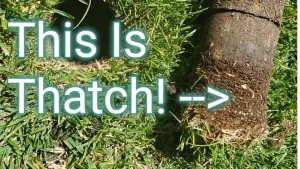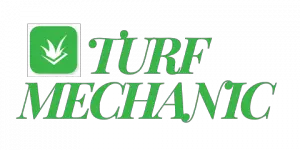If you’ve got a nice looking lawn, that’s comfortable under your feet, but it still feels more spongy or squishy than normal then your grass’ root system is probably pretty shallow. It is most likely building up inside a layer near the top of the soil surface called the thatch layer.
All lawns have a thatch layer, although some grass types have a more pronounced thatch layer than others. When this layer starts getting too thick then problems start arising.
A soft or squishy lawn is a common symptom of a thatch layer that is too thick. The spongy material that forms the thatch layer holds moisture and nutrients on top of the soil leaving grass susceptible to disease, drought, and nutrient deficiencies.
Usually the excessive build up of old and dead grass roots, stems, rhizomes, and stolons is the likely culprit behind why your lawn is spongy or squishy.
When all of this old, dead grass material accumulates faster than the microbes in your soil can decompose it, the layer grows thicker making the problem worse over time. Eventually the root systems of your grass start growing even more shallow as they continue to chase moisture and nutrients that are located above the soil level, in the thatch layer, further also expanding the problem.

Thatch Layers Cause That Soft Spongy Feeling In The Lawn
This layer of material located above the soil but below the leaf canopy of your lawn is referred to as “thatch” by lawn and garden pros everywhere and it needs to occasionally be managed with a thatch remover…or in my opinion the routine application of liquid thatch removal products which work by energizing the microbes that ordinarily eat the debris returning it all to the soil.
Kind of like heating up a compost pile for faster decomposition.
I use N-EXT D-Thatch for this and because it’s a liquid it’s easy enough to mix in with my regular fertilizers so I don’t have to make any extra applications…or I just attach the bottle right onto my hose for simple spraying.
I also dethatch surface debris out of parts of my lawn on occasion using a dethatching rake (click to see what a thatch rake looks like) or I may run an electric dethatcher over the larger sections of my lawn. Both of these tools improve air flow and water penetration into the thatch layer which can help with decomposition especially when a liquid dethatching product is applied to my lawn regularly throughout the growing season.
► How Liquid Thatch Removal Products Work & Which Is Best
The electric dethatcher I use is the VonHaus 15″ unit, but it is not in stock any more on Amazon, so make sure to see my comparison of the other top electric dethatchers here if you’d like to buy a new lawn toy.
► My Multifaceted Approach To Removing Lawn Thatch
You can also see my recommendations for liquid thatch digesters on this page or see my recipe for making your own liquid dethatcher here.
Why Spongy Thatch Filled Lawns Is A Bad Thing
While it may feel nice to have a spongy or squishy lawn for walking on with bare feet, it will quickly result in many negatives to your lawn due to the limited ability of the grass to get the water, fertilizer, and exchange of oxygen in the soil that is needed for a healthy lawn.
If you have not incorporated dethatching into your annual grass management strategy than now is the time to get caught up on dethatching and all the benefits that it provides your lawn.
Here’s an article published on this site about getting the timing right for lawn thatch removal in the Spring.
What Causes Squishy or Spongy Lawns
- Excessive thatch build up on the surface of soil from dead grass, rhizome roots, and other yard debris
- Poor drainage and water management on the property
- Excessive irrigation or rainfall that can sit
- Heavy clay soils that resist water drainage
- Low lying area of the yard that gathers rain water or irrigation
How Does Thatch Build Up
Your yard will build up a layer of thatch which is comprised of dead grass, roots, and yard debris such leaves, sticks, and other plant matter. Many lawn mowers leave grass clippings in the lawn as their several benefits that they provide as they break down to grow healthy green grass. However, when the lawn clippings are left long and stay on the grass they can contribute to a quick accumulation of thatch on the ground.
Varieties of grass that spread by rhizome and/or stolon are also significant contributors to the development of thatch resulting in a lawn that is spongy or squishy when walking on it. You can learn a lot more about what causes thatch to build up in a lawn here.
What Damage Does Thatch Cause the Yard
- Thick thatch prevents irrigation or rain water to reach the soil and penetrate deep into the root zone. This is often the biggest cause of homeowners experiencing dead patches of grass during the warmer months despite regular watering schedules.
- It can eliminate the soils ability to dry out as well, so the moisture that does get through sits and can cause disease
- Fertilizers are prevented from reaching the root zones where they assist the grass to grow healthy and green.
- Restricts airflow to the root zone increasing the carbon dioxide levels in the soil making it more difficult for grass, but also shrubs and trees nearby to have adequate aeration around their root zones for healthy development.
How to Fix a Spongy or Squishy Lawn
The first line of attack to resolving a spongy or squishy lawn is to remove the excess thatch and then you can properly evaluate if you are having any other issues related to the soil composition or drainage issue that may be the root cause of a always extra wet area in your lawn.
Simple Dethatching Steps
- Generally, best done in early Spring and/or late summer for cool season grasses and late Spring for warm season grass types, it’s wise to dethatch just before or during the explosive growth that is common in lawns everywhere. Many cool season lawns also put on a lot of growth in the fall so late summer or early fall is another good time to get this job done.
- Use a strong tines thatch rake or electric dethatcher machine to loosen up the top layer of thatch and remove it from the lawn. It is ok to be aggressive and rake the ground hard to pull out all the dead and decomposing material.
- Use a dethatching machine if the thatch is thicker than ½ an inch. Go over the entire yard or area of concern in one direction and then go over the area again from the other direction.
- Once thatch or surface debris is elevated you should bag it and discard. The best plan is to use this thatch in your compost pile but of course not everyone keeps a pile so discard in your local municipal compost dump site if you have one.
This should solve the vast majority of homeowners issues of a lawn being squishy or spongy, however if it persists than you likely have a soil composition issue or need drainage assistance to channel the flow of water on your property to avoid settling in your lawn.
Lawn is Spongy or Squishy, But Thatch is Not the Problem?
Do You Have Heavy Clay or Too Much Organic Matter?
Heavy clay soils are known to have drainage problems and the water may pool up and result in a very squishy or spongy part of the lawn. Soils that are rich with organic materials will retain lots of water and can lead to an incredibly soft ground when it is full of moisture. While a lawn and garden professional may have you take a soil test and apply amendments to the soil that is often best left to professionals.
You may read online that people will recommend adding sand to the lawn to assist in the drainage of the soil when they have too much organic matter. The sand will quickly improve the drainage of the soil, however this can be a labor intensive project and will need to have you lay new sod or overseed grass seed to bring your grass back after rototilling in sand to the soil. However, do not just run out and get sand for a squishy or spongy location as you need to be careful when adding sand. Add it to the wrong type of clay soil and it will result in turning your soil into concrete making the ground even more compacted than it already is.
Add a Drainage Line
Add a drainage ditch with a corrugated drainage pipe is a very simple way to redirect the excess water running across your lawn and help keep your from turning into a swampy bog with a squishy or spongy feel as you walk across it. It is important when running a drainage line to remember that water will travel downhill so you need to plan ahead where you want to capture the water and where it will ultimately get redirected to. Keep a slight decline in your drainage line and you will enjoy a nice firm lawn that is no longer boggy all year long.
Liquid Aeration or Core Aeration Always is Helpful
If you have dethatched your yard and resolved any potential drainage issues, but still have a squishy or spongy lawn consider aerating the lawn. The biggest benefit to lawn aeration is that improves the soil drainage which will help it dry out in between watering and bring back the firmness to the ground that you desire. Core aeration and liquid aeration both work in improving drainage and delivering nutrients and oxygen to the root zones of the grass.
Core aeration is a good first step as it will provide a fast and immediate effect by removing the core plugs exposing the soil to the air. Liquid aeration is a great plan for ongoing lawn maintenance and can work on every square inch of the lawn not just the areas immediately adjacent to the core plugs from a core aeration.
In conclusion
Why is your lawn squishy or spongy? It is likely several factors that have combined to create a boggy mess in your otherwise perfect lawn. It can be addressed through several specific steps and is not something that one should just throw up their hands and live with. Allowing the lawn to stay squishy and spongy will result in a muddy mess during certain times of year at best and at worst could result in a family member or friend injuring themselves when walking on the soft ground.
Dethatch your yard, improve the drainage of the soil if needed, maintain proper water management with a drain line if necessary and include a routine soil aeration to keep your lawn from turning back into a wet and soggy, muddy mess that is squishy and spongy to walk on.

